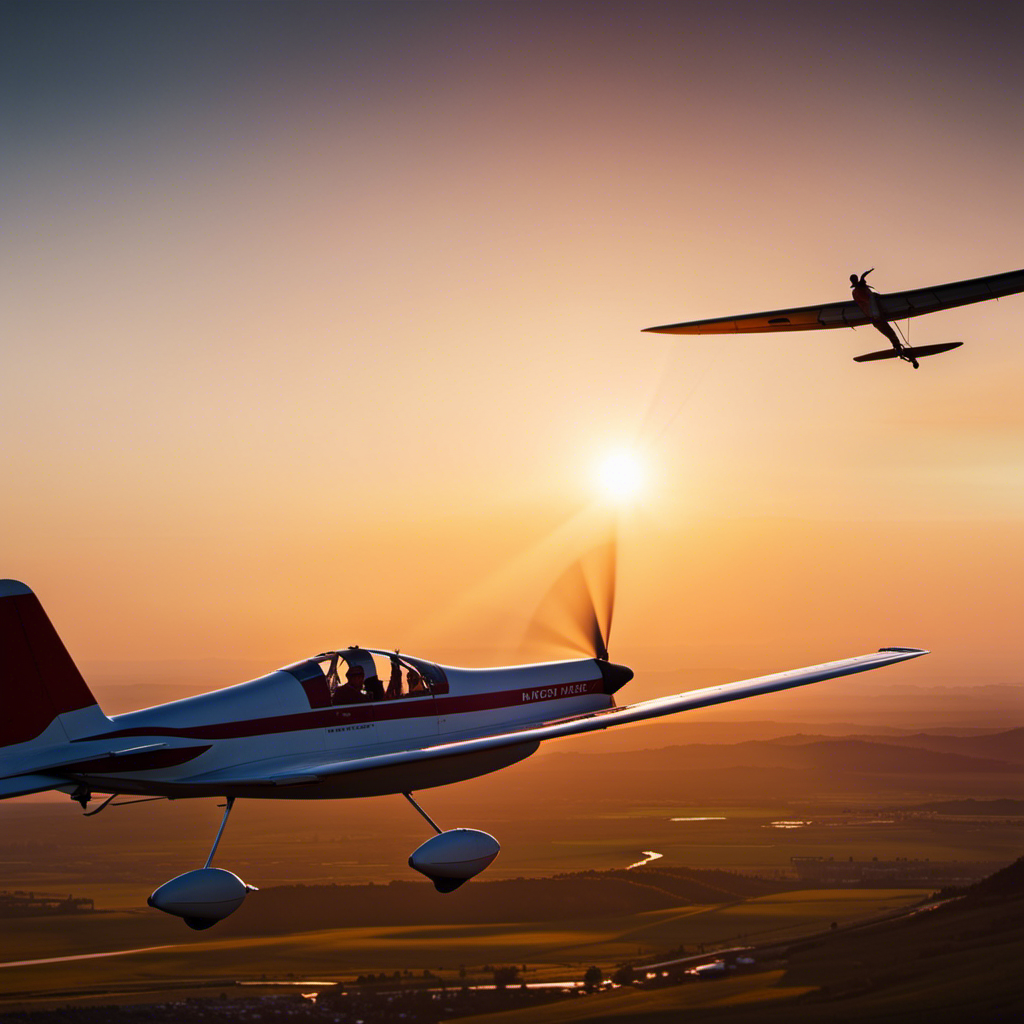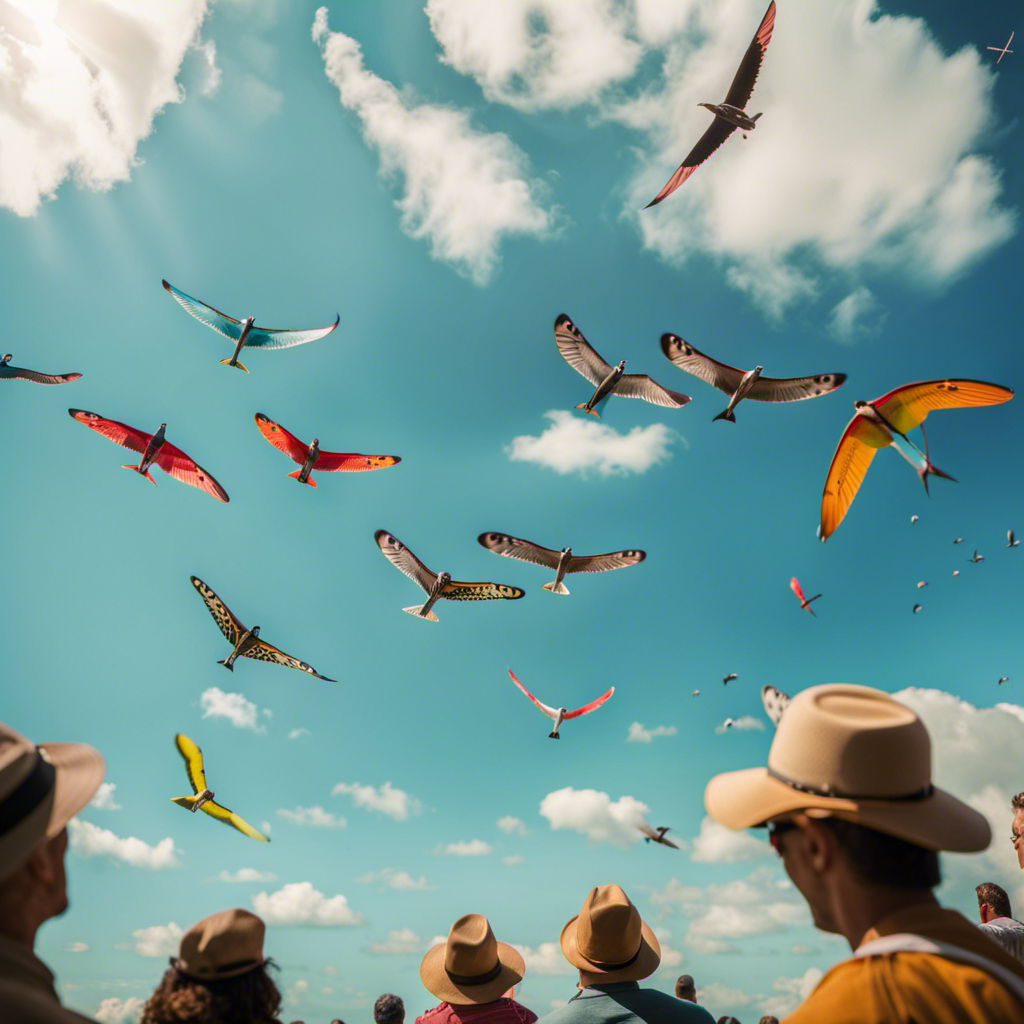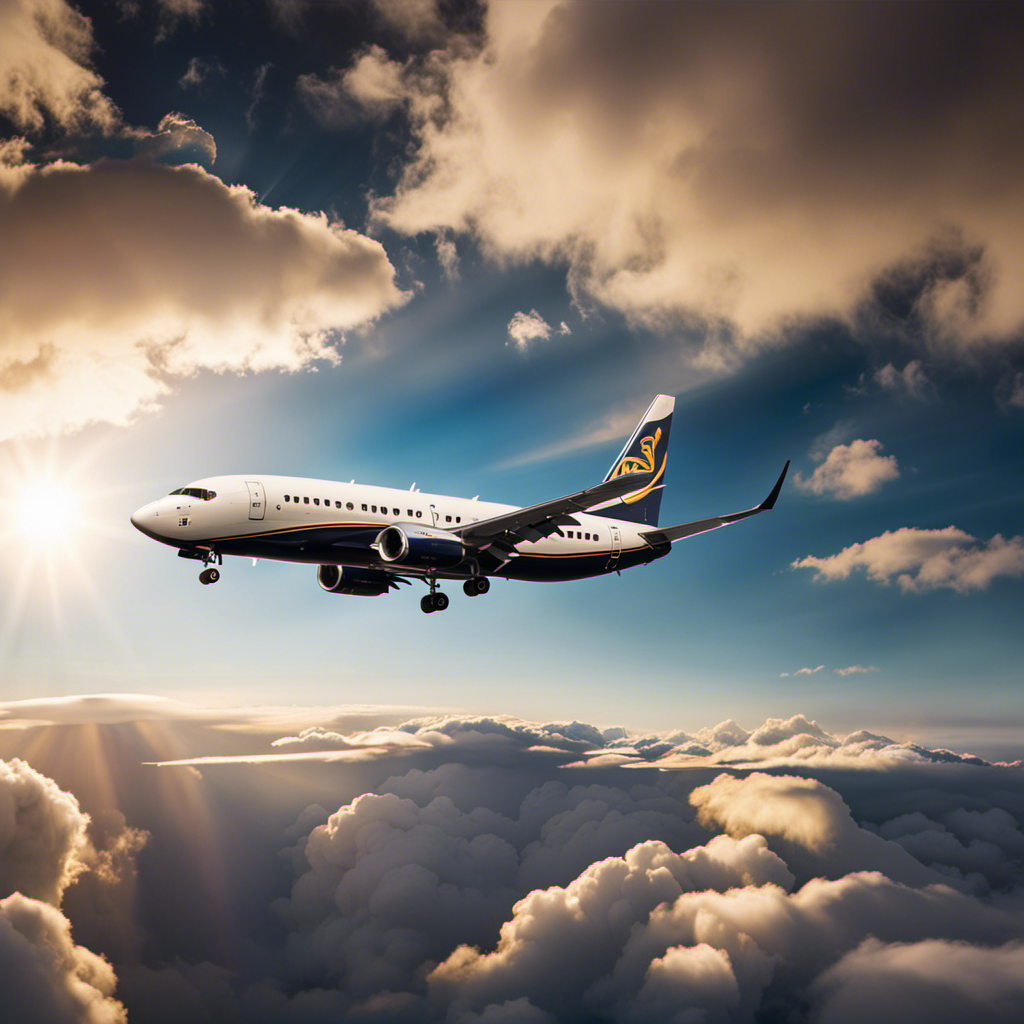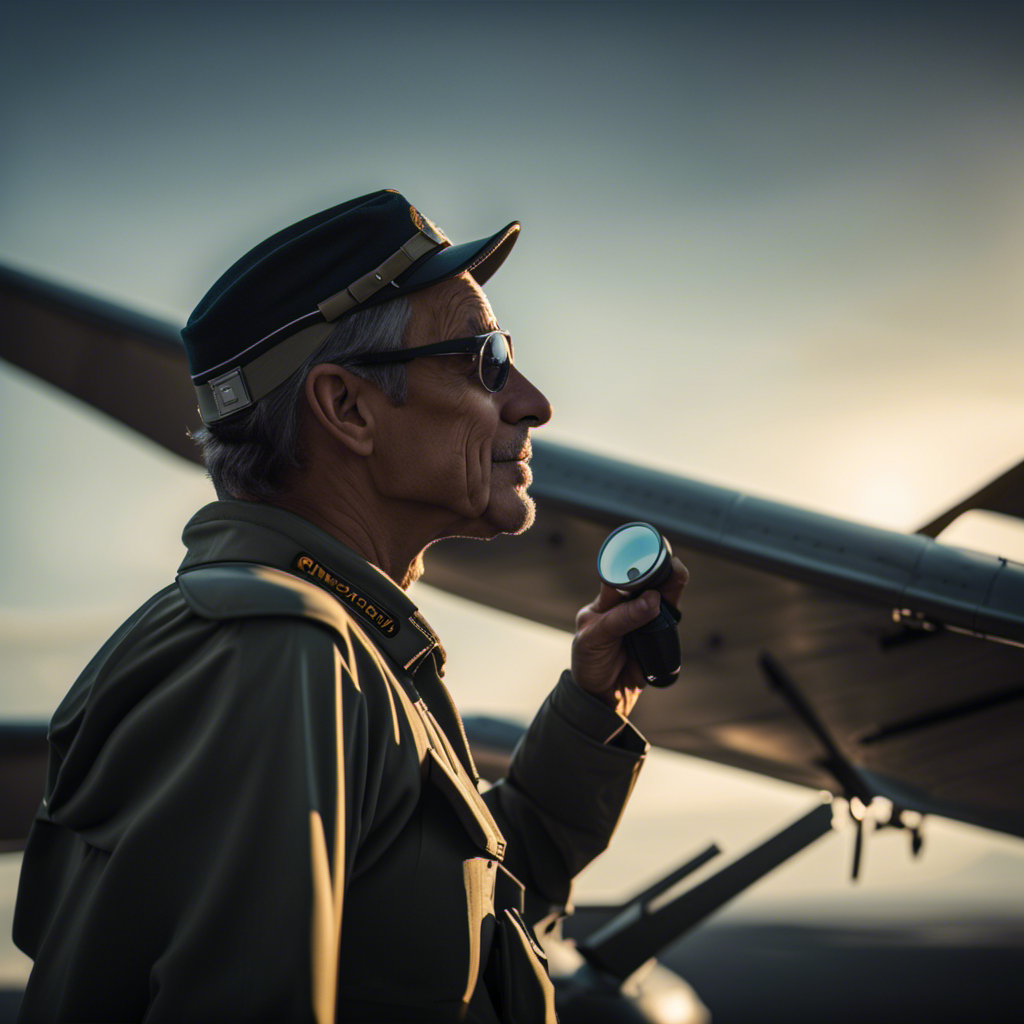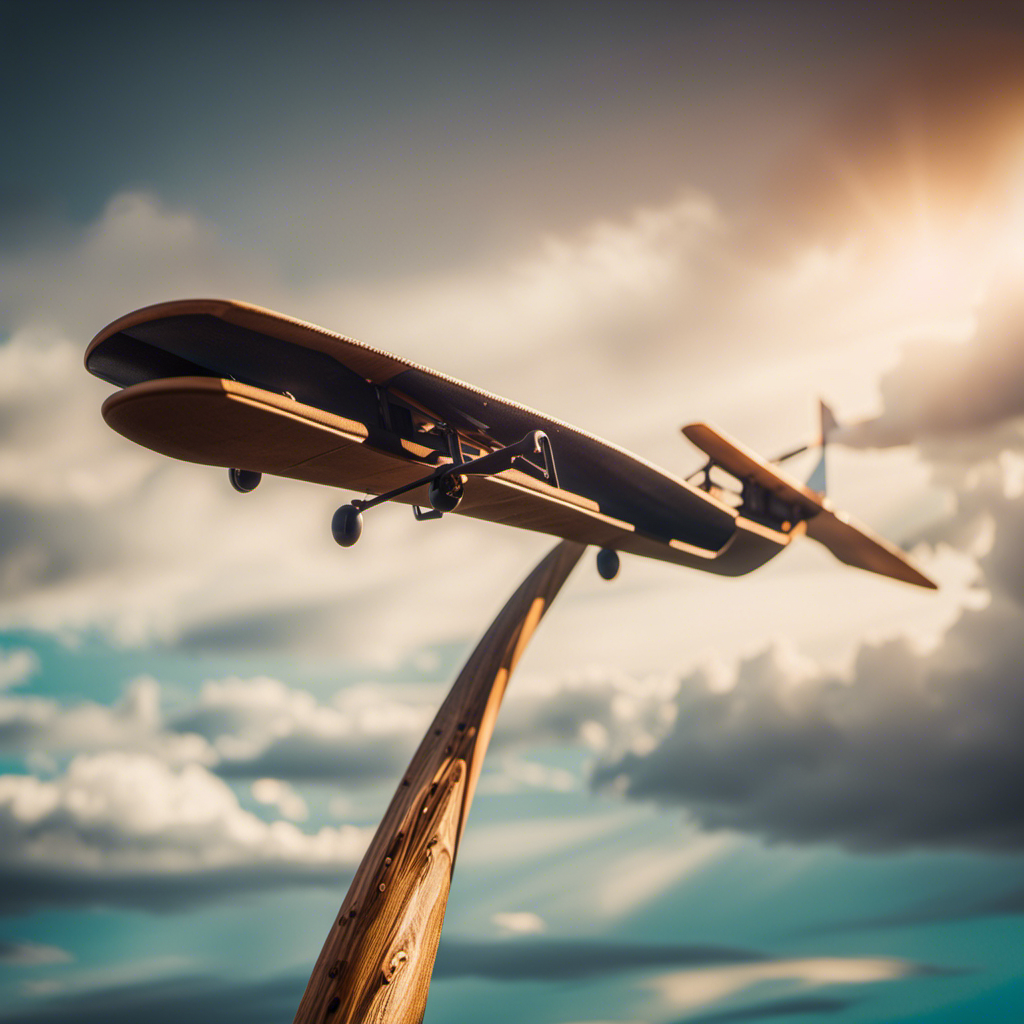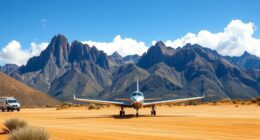The art of flying glider planes has always captivated me. Were you aware that pilots of gliders can navigate the skies for hours on end without the use of an engine? This ability demands accuracy, understanding, and consistent practice.
In this article, I will guide you through the process of mastering the glider, providing comprehensive training on everything from understanding the basics of flight to navigating the glider in the air.
Get ready to embark on an exhilarating journey into the world of glider plane training.
Key Takeaways
- Safety precautions and understanding weather conditions are essential for glider plane training.
- Regular maintenance and inspections are necessary for the longevity and performance of glider planes.
- Joining a glider club or community offers various benefits, including training programs and a supportive network.
- Competitions and cross-country flights help enhance skills, decision-making abilities, and confidence in glider flying.
Understanding the Basics of Glider Flight
Now that you’ve learned the fundamentals of glider flight, it’s time to delve deeper into understanding the basics of gliding.
Gliding is a unique form of aviation that relies on the power of the atmosphere to stay aloft. It involves utilizing the natural upward currents of air, known as thermals, to gain altitude and maintain flight. By carefully reading the weather conditions and using precise control inputs, a glider pilot can navigate through the sky with precision and grace.
Understanding the principles of lift, drag, and gravity is crucial for successful glider flight. Mastering these concepts allows pilots to maximize their time in the air and perform advanced maneuvers.
Now, let’s move on to learning the different types of glider planes, which will further enhance your gliding knowledge and skills.
Learning the Different Types of Glider Planes
Take a moment to familiarize yourself with the various types of glider planes you’ll encounter during your training. Understanding the different types of glider planes is essential for becoming a skilled pilot.
Here are the two main categories you need to know:
-
Single-Seat Gliders:
- Standard Class: These gliders are designed for cross-country flights and have a wingspan of 15 meters. They offer excellent performance and are commonly used in competitions.
- Open Class: These gliders have a wingspan of up to 28 meters and are built for maximum performance. They are often used for long-distance flights and world records.
-
Two-Seat Gliders:
- Training Gliders: These gliders are specifically designed for flight training. They have dual controls, allowing the instructor to guide the student pilot during the learning process.
- Touring Gliders: These gliders are larger and more comfortable, making them ideal for scenic flights and cross-country adventures.
By understanding the different types of glider planes, you’ll be better prepared for your first solo flight and the challenges that lie ahead.
Now, let’s delve into how to prepare for this exciting milestone.
Preparing for Your First Solo Flight
Preparing for your first solo flight can be both exhilarating and nerve-wracking. As a glider pilot, it is crucial to approach this milestone with precision and thoroughness.
The first step is to ensure that you have completed all necessary ground training, including studying aerodynamics, navigation, and emergency procedures. Familiarize yourself with the specific glider model you will be flying, understanding its controls and limitations.
Additionally, practice simulated solo flights with an instructor to gain confidence and proficiency. Once you have mastered the necessary skills, it’s time to focus on mastering takeoff and landing techniques. These fundamental skills require precise control inputs and an understanding of wind conditions.
Mastering Takeoff and Landing Techniques
To ensure a successful takeoff and landing, you need to focus on maintaining precise control inputs and being aware of wind conditions. Here are four key techniques to master for a smooth and safe takeoff and landing:
-
Control inputs: Use the control stick or yoke to maintain a balanced attitude throughout the takeoff and landing phases. Make small adjustments as necessary to correct for any deviations.
-
Speed management: Monitor your airspeed carefully and adjust it according to the specific requirements of your glider. Maintain the recommended speeds for takeoff and landing to ensure optimal performance.
-
Flap settings: Understand the appropriate flap settings for different phases of flight. Extend the flaps as needed during takeoff for improved lift and control, and retract them gradually during the landing approach.
-
Wind assessment: Continuously assess wind conditions to anticipate their impact on your glider. Consider factors such as wind direction, speed, and gusts, and make adjustments to your approach accordingly.
Navigating and Controlling the Glider in the Air
As I navigate and control the glider in the air, I must remember to anticipate and respond to any changes in wind conditions. This is crucial for maintaining stability and ensuring a smooth flight.
Constantly monitoring the wind direction and speed is essential, as it affects the glider’s performance and maneuverability. By paying close attention to the wind, I can make timely adjustments to my flight path and control surfaces to optimize lift and minimize drag.
Additionally, understanding how wind interacts with the terrain and other obstacles is vital for safe navigation. By applying these principles, I can confidently navigate the glider through various flight conditions.
Preparing myself for the next section on advanced glider maneuvers and aerobatics, where precise control and coordination are paramount, requires a solid understanding of these concepts.
Advanced Glider Maneuvers and Aerobatics
You’ll have a blast learning advanced glider maneuvers and aerobatics, as they require precise control and coordination to execute breathtaking aerial tricks. These maneuvers are not only exhilarating but also crucial for mastering the art of glider flying.
Here are three essential advanced maneuvers that every glider pilot should know:
-
Loop: This classic aerobatic maneuver involves pulling the glider up into a vertical climb and then completing a full 360-degree loop, experiencing both positive and negative G-forces.
-
Spin: Spins are controlled stalls that involve a combination of yawing and rolling motions. Learning to recover from a spin is vital for maintaining control in emergency situations.
-
Barrel Roll: This maneuver is a combination of a loop and a roll, where the glider rolls while simultaneously climbing or descending. It requires precise rudder and aileron inputs to maintain a smooth and coordinated motion.
Mastering these advanced maneuvers will enhance your flying skills and broaden your understanding of the glider’s capabilities.
Now, let’s delve into understanding weather conditions and safety precautions for glider flying.
Understanding Weather Conditions and Safety Precautions
Understanding weather conditions and safety precautions is essential for safe and successful glider flying.
As a glider pilot, it is crucial to have a thorough understanding of the current weather patterns and how they can affect your flight. By analyzing weather forecasts, wind direction, and cloud formations, you can make informed decisions about when it is safe to fly and when to postpone your flight.
Additionally, being aware of safety precautions such as wearing appropriate safety gear, conducting pre-flight inspections, and maintaining proper communication protocols with air traffic control ensures a safe and enjoyable flying experience.
Now that we have discussed the importance of weather conditions and safety precautions, let’s transition into the next section about maintaining and inspecting your glider.
Maintaining and Inspecting Your Glider
Now that we’ve covered the importance of weather conditions and safety precautions, let’s move on to maintaining and inspecting your glider.
To ensure the optimal performance of your glider, it is crucial to regularly inspect and maintain its various components. Here are some key tasks to consider:
- Check the control surfaces for any signs of damage or wear.
- Inspect the cables and pulleys to ensure they are properly tensioned and free from fraying.
- Examine the landing gear for any cracks or structural issues.
- Clean the canopy and check for any scratches or cracks that could impair visibility.
- Inspect the parachute system to ensure it is in good working condition.
By diligently maintaining and inspecting your glider, you can ensure its safety and longevity.
Now, let’s explore the benefits of joining a glider club or community, where you can further enhance your skills and knowledge.
Joining a Glider Club or Community
Joining a glider club or community can provide you with valuable opportunities to connect with other enthusiasts and expand your knowledge of the sport. Being part of a glider club allows you to engage in discussions, share experiences, and learn from experienced pilots. These clubs often organize club flying days, where members can fly together and gain exposure to different flying conditions. Additionally, many glider clubs offer training programs and workshops to help you improve your skills and stay up to date with the latest techniques and safety measures. By joining a glider club, you can also access resources such as flight simulators and specialized equipment. Overall, being part of a glider club or community enhances your passion for gliding and provides a supportive network of fellow glider enthusiasts.
| Benefits of Joining a Glider Club or Community | ||
|---|---|---|
| Opportunity to connect with other enthusiasts | Access to training programs and workshops | Exposure to different flying conditions |
| Engaging in discussions and sharing experiences | Access to flight simulators and specialized equipment | Supportive network of fellow glider enthusiasts |
Transitioning to the next section, taking your glider skills to the next level: competitions and cross-country flights, opens up new challenges and opportunities for growth.
Taking Your Glider Skills to the Next Level: Competitions and Cross-Country Flights
Transitioning to the next level, competing in glider competitions and embarking on cross-country flights, offers exciting challenges and opportunities for growth.
Participating in glider competitions allows me to test my skills against other experienced pilots, pushing me to improve my performance and decision-making abilities. These competitions require precise navigation, strategic planning, and excellent communication skills. It is a chance to learn from fellow pilots and gain valuable insights into different flying techniques.
Cross-country flights, on the other hand, provide an opportunity to explore new territories and navigate through unfamiliar landscapes. It requires careful planning, understanding of weather patterns, and efficient use of thermals to cover long distances. These experiences not only enhance my piloting skills but also instill confidence and create lasting memories.
Transitioning to this level of glider flying is a thrilling and rewarding journey that fuels my passion for aviation.
Frequently Asked Questions
How long does it take to become proficient in glider flying?
It typically takes several months of consistent training and practice to become proficient in glider flying. This includes learning the principles of flight, mastering maneuvers, and gaining experience in various weather conditions.
Are there any age restrictions for learning to fly glider planes?
Yes, there are age restrictions for learning to fly glider planes. Similar to obtaining a driver’s license, one must be at least 14 years old to solo and 16 to obtain a private pilot certificate.
Can I fly a glider if I wear glasses or contact lenses?
Yes, you can fly a glider if you wear glasses or contact lenses. As long as your vision is corrected to meet the required standards, there are no restrictions in terms of eyewear.
Are there any weight restrictions for flying glider planes?
Weight restrictions for flying glider planes exist to ensure safety. The maximum weight limits are set by the manufacturer and must be adhered to. It is crucial to respect these restrictions for optimal performance and to prevent any potential risks during flight.
Is it possible to fly a glider plane at night?
Yes, it is possible to fly a glider plane at night. However, it requires special equipment such as navigation lights and a clear understanding of night flying procedures to ensure safety.
Conclusion
In conclusion, mastering the art of glider plane training is a comprehensive journey that requires dedication and practice. By understanding the basics of glider flight and learning about the different types of glider planes, one can gradually prepare themselves for their first solo flight.
With thorough knowledge of takeoff and landing techniques, as well as navigating and controlling the glider in the air, pilots can confidently soar through the skies. It is crucial to always prioritize safety by understanding weather conditions and consistently maintaining and inspecting the glider.
By joining a glider club or community, pilots can immerse themselves in a supportive network of fellow enthusiasts. And for those seeking an adrenaline rush, participating in competitions and embarking on cross-country flights will take their glider skills to new heights.
So, strap in and get ready to soar like never before – the sky’s the limit!
With a heart that soars as high as the skies, Aria, affectionately known as “Skylark,” is the driving force behind Soaring Skyways. Her journey into the gliding world began as a young dreamer gazing up at the soaring birds, yearning to experience the weightlessness and freedom they embodied. With years of experience both in the cockpit and behind the scenes, Aria’s commitment to the gliding community is unwavering.
